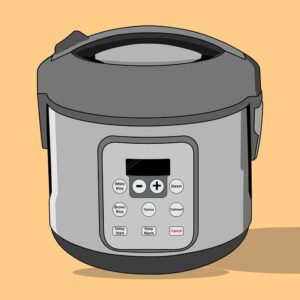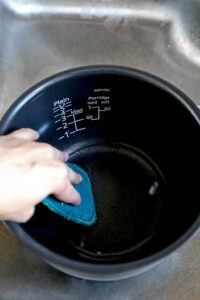Proper maintenance of kitchen appliances is the solution to tasty foods prepared in homes. However, maintaining doesn’t necessarily entails inspecting issues in the components forming them. Regular cleaning is the first-most way you can employ to maintain these appliances running efficiently for a long.
Rice cookers are part of essential kitchen appliances in our homesteads. Cleaning them can turn both easy and challenging to different groups of people. Our article today handles more about cleaning the inside of rice cookers broadly.
How to Clean the Inside of Rice Cookers

Cleaning rice cookers is maintaining them in the right shape to give you a long-term service. Cleaning rice cookers removes both stuck rice in hard-to-reach places as well as abnormal odors.
Before we extend our discussion to the steps involved in cleaning rice cookers, there are precautionary measures you should adhere to. Rice cooker manufacturers pack these kitchen appliances with user manuals. It’s advisable to read through it before indulging in the actual process. Safety precautions enable you to accomplish the task without causing damages to the device. Some precautionary measures include;
First, electrical experts advise people not to leave any electrical part exposed to water. Normally, it’s at the base where the rice cookers have an electrical connecting platform. Therefore, you need to keep this part dry all the time.

Image credit: Tiger Corporation
Another important part to watch includes the plate located inside these devices. The plates then carry the role of providing heat to the cooker once switched on. Ensure no traces of water on the parts to avoid instances of electric shock that might damage your rice cooker.
Before washing your rice cooker, it’s important you take off the lid and inspect the hotplate. You need to wait for the hotplate to cool completely before you start washing it. Normally, manufacturers recommend about half an hour wait time after unplugging the device. This is sufficient time for the components to cool down.
According to cookwaredaily what steps do expert cleaners follow in accomplishing such a project? Look at the professional guide below to get you to the point.
Allow the Machine to Cool to Room Temperature
As we have learned above, you don’t rush cleaning a rice cooker while still hot. Mostly, the parts you give time to cool include the steam cap, lid, and the inner pot. About 30 minutes is sufficient for these components to lose temperature completely.
Removing the Parts Gently
Once they are at room temperature, remove the gaskets, inner pot, spatula, steam cap, dew collector and inner lid. Ensure you gently remove them using both hands for the general safety of the component.
Prepare a Sanitizing Solution
There is a need to employ the right cleaners for this project. Gather the following to make your sanitizing solution;
- Dishwashing liquid
- Hot water
- A chlorine bleach
Ensure the ingredients are enough to wash the inside surface the best way. Consequently, only hot water is recommended to wash rice cookers.
Cleaning the Cooker
After preparing your solution, get a moist cloth for the task. Moist cloth removes all food material stuck inside the cooker easily. Ensure you allow drying time before returning the inner pot to its place.
Other residues are hard to remove. How can you get them off from the cooker inside surfaces? Get sandpaper to get off the sticky residues in these appliances. Provide the hot plate a hard and continuous rub until everything scrubs off.
Other manufacturers recommend using metal utensils to get rid of stubborn rice bits. However, this isn’t a good way, try with sandpaper until you remove them completely.
Read also: How to Clean Inside Air fryer: Best Way to Clean Air fryer Interior & Exterior
Cleaning Other Rice Cooker Components
Now, above is a quick guide on how to clean the inner surfaces of rice cookers. However, it’s not only the inside surface you should clean. Instead, you should maintain other components that are also clean all the time. Let’s again look further into cleaning other components separately.
The Lid
Most rice cookers come with detachable lids. You need to use hot water and soap and clean it just like cleaning the pot. However, other cookers have attached lids. For this, get a sponge to clean its interior surface carefully. Ensure water doesn’t spit into the cooker while cleaning this component.
The Hotplate
Hotplates are essential components of rice cookers. Usually, manufacturers recommend washing these components using a wet washcloth.
After a long period of use of a rice cooker without washing, hotplates normally turn brownish. This signifies the extent of burn they have received throughout this period. Here, you require sandpaper to scrap all traces of food particles stuck on the hotplate.
While scraping off the remains, ensure the surface remains smoothest. A smooth surface ensures there is even heating of the rice in the pot. Moreover, the smoothness ensures there is complete connection or contact of the hotplate and inner pot.
Exterior Surface
Cleaning the exterior surface of your rice cooker is also paramount. You will employ a damp cloth to perform this task. Wipe off any stain or food residue on this surface carefully. Cleaning the cord is also essential here. For this, employ a dampened cloth to wipe off all dirt properly.
Other Accessories
Apart from the above components, rice cookers have several accessories to use alongside. For instance, there is a ladle and a steamer tray. Consequently, there is a measuring cup and others come with condensation collectors. Rice cooker manufacturers recommend owners wash these accessories in a dishwasher. However, if you seem to have time, wash the cooker by hand.
Conclusion
Cleaning your rice cooker provides you an opportunity to use it for an extended period. Before performing your routine cleanup exercise, note the precautionary measures set by the rice cooker manufacturers. Follow to form an excellent sanitizing solution for your project. Employ your manual and ensure you maintain everything as stated. Incorporate the cleaning manual ideas above to set your rice cooker ready for the next meal preparation session.

Leave a Reply